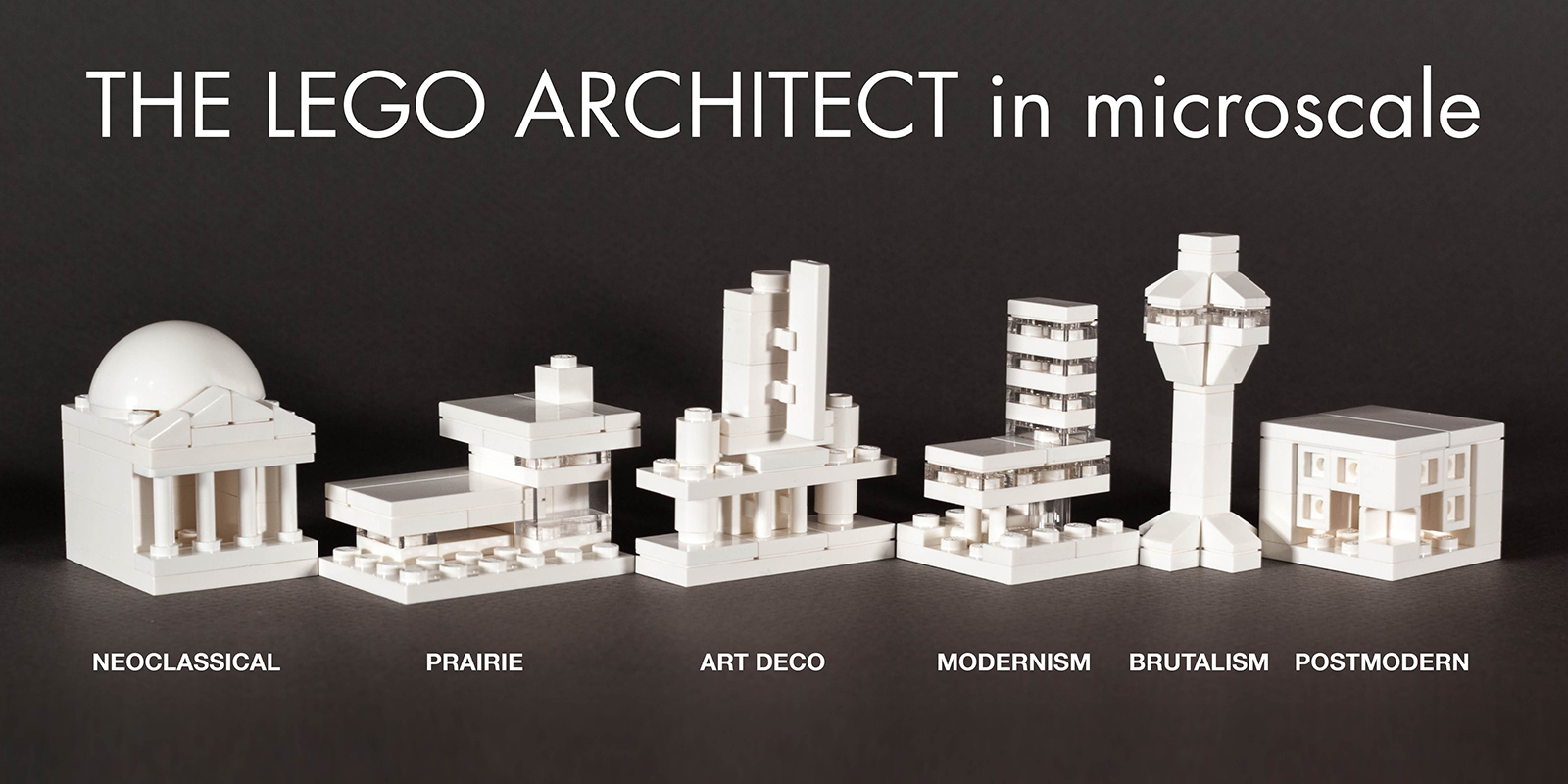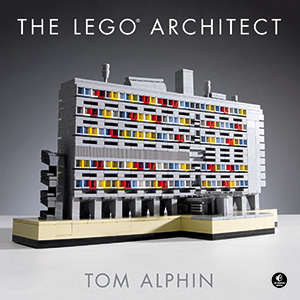Nanoscale models of THE LEGO ARCHITECT
Can we tell the history of architecture using 20 LEGO bricks or fewer? Let’s find out!
Readers of THE LEGO ARCHITECT will recognize this collection of miniature LEGO Architecture models, which I created for the 2015 Alternate Advent Calendar contest at brickset.com. In compliance with the contest rules, each of these models is built using 20 or fewer LEGO parts (as compared to the larger versions featured in the book which use 200 LEGO parts or more.) Creative parts usage, and a high degree of abstraction is required to create convincing microscale models.
Each of these models is representative of a prominent style of Architecture, covering more than 200 years of architectural history. (To learn more about these architectural styles, check out my book, THE LEGO ARCHITECT.)
NOTE: The common description of scale for LEGO projects is that a model built at a scale of about 1:36 to 1:50 is “Minifig Scale”, and anything smaller than this is “Microscale”. As such, even the models in my book are Microscale, so I shall use a different term to describe these aggressively tiny models: “Nanoscale”.
The first is a nanoscale Neoclassical building. Neoclassical architecture was prominent from about 1750-1900, and is still commonly used for governmental buildings. I removed the building’s wings to fit the 20 part limit, but the iconic Neoclassical features such as the columns and domed roof are clearly visible in this tiny model.

LEGO model based on Willits House as featured in The LEGO Architect (left), Nanoscale Willits House (right)
Next we have a nanoscale Prairie style home, based loosely on Willits House by architect Frank Lloyd Wright. The style peaked around 1910, although the influence of their open floor plans is clearly visible in Modern residential architecture. This model uses carefully chosen 1/2 brick offsets. I covered up the gaps in the front by using a 1×2 panel as the front window.

Instructions to build a Nanoscale Prairie style home.
Update 12/24/2015: I created instructions to build this nanoscale LEGO model which uses just 21 LEGO bricks.
DOWNLOAD LINK: THE_LEGO_ARCHITECT-Nanoscale_Prairie_Home.pdf
Third, we see a nanoscale movie theatre in the Art Deco style. Art Deco is the architectural style of choice in the Roaring 20’s, celebrating wealth with decadent materials and elaborate facades. This model uses some uncommon parts for the front columns, and the marquee is carefully attached with 1×2 Clip Bricks.
Modernism came next, and took the world by storm. It is often described by the famous quote “Less is more” by architect Mies van der Rohe. This nanoscale building is based on Lever House, a beautiful early Modernist office building in New York City. Clear plates create the tiny floors of the building, and a 1×1 clear round brick raise the second story of the building from street level.

Brutalist LEGO Air-traffic Control tower as featured in The LEGO Architect (left) and in Nanoscale (right)
Brutalism is an offshoot of Modernism which celebrates the creative potential of Concrete. This nanoscale model is based on the many concrete Air Traffic Control towers which were built during the 1960’s and 70’s. 1×1 “Cheese” slopes give it’s conic angular appearance.
We wrap up with a Postmodern office building, based on Ransila I, an office building in Switzerland by architect Mario Botta. In Postmodern architecture, we see a broader exploration of forms which revisit classical forms and eschew the sterility of Modernism. This nanoscale model uses the same technique as the larger version, using outward facing 1×1 plates to represent windows.
Closing thoughts
Have you tried to build “Nanoscale” models before? It’s a great challenge, but really neat to see how you can use unusual pieces in unconventional ways to capture the essence of a building with just a few LEGO pieces.
Notably missing from this collection is a nanoscale model based on “High Tech” architectural style also featured in The LEGO Architect such as the works of Santiago Calatrava or Frank Gehry. I did some brief explorations, but couldn’t find a way to create these abstract forms using so few LEGO elements.








Tom –
Since everything smaller than minifig scale is considered microscale, and yet there is a wide variation of sizes within the microscale designation, is there some sort of nomenclature for different sizes? You use nanoscale here. I’ve seen reference to picoscale. Are there others? and if so, what how do you determine what scale you might call a MOC? Or is it just personal preference as to how you might classify a build?
Thanks
-wayne-
Wayne, I am not aware of a generally agreed-upon nomenclature for various scales smaller than Microscale. I personally see “Microscale” as smaller than Minifig scale, and “Nanoscale” referring to the smallest scale where the model remains recognizable.
I hope that helps!
Hi Tom, I hope you don’t mind, but I’ve been trying to recreate these nano models because I really like their look, specially next to their bigger brothers. It has been mostly easy, except for the prairie model, I would be very lost without those instructions. I do have a problem with two of the buildings: in the Art Deco building, what goes between the two round bricks on the second floor? and on the postmodern building, how do you manage to get those bricks to hang on the side? Would love to know those two small details!
Thanks for your feedback! I do not have any immediate plans to share the instructions for these other models, but I will say that the Art Deco model uses a 2×2 jumper, with a 1×3 plate on top of that. It’s only attached by a single stud, so it can spin a little. you could use two 1×2 jumpers instead if you preferred, and this would prevent it from spinning.
—tom
As with all your models I am just blown away by your skill. Keep up the inspirational work for those of us who are still learning..